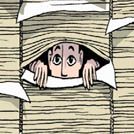I spent the five happiest years of my life in a morgue. As a forensic scientist in the Cleveland coroner’s office I analyzed gunshot residue on hands and clothing, hairs, fibers, paint, glass, DNA, blood and many other forms of trace evidence, as well as crime scenes. Now I'm a certified latent print examiner and CSI for a police department in Florida. I also write a series of forensic suspense novels, turning the day job into fiction. My books have been translated into six languages.
I have no idea. You'll have to ask the agency to which you are applying. They may all have different requirements.
I'm so sorry for your loss! However I doubt I could tell you anything more. I believe it's impossible to tell exactly what physics will take place. If you'd like, email me at Lisa-black@live.com with your details and I'll see if I can give you any opinions that might help.
Sure, I'll email you.
I just tried to email you and it came back undeliverable. You can email me at lisa-black@live.com.
Sure, email me at Lisa-Black@live.com
Fashion Model
 What's the most lucrative type of gig models can book?
What's the most lucrative type of gig models can book?
Hotel Travel Blog Active 2019
 What do you do if a guest is doing something illegal in a room?
What do you do if a guest is doing something illegal in a room?
Social Security Employee
 How do you check to see whether someone claiming disability is actually disabled?
How do you check to see whether someone claiming disability is actually disabled?
I like doing both, because being in the lab all the time can get tedious, but being at crime scenes all the time can get exhausting.
It almost certainly would not be a deal-breaker. Just tell them the truth.
That depends on what job you're applying for--does it entail more lab work or more scene work? The only way to know for sure is call the places you might want to work and ask, or at least check out job postings online.
-OR-
 Login with Facebook
Login with Facebook (max 20 characters - letters, numbers, and underscores only. Note that your username is private, and you have the option to choose an alias when asking questions or hosting a Q&A.)
(A valid e-mail address is required. Your e-mail will not be shared with anyone.)
(min 5 characters)
By checking this box, you acknowledge that you have read and agree to Jobstr.com’s Terms and Privacy Policy.
-OR-
 Register with Facebook
Register with Facebook(Don't worry: you'll be able to choose an alias when asking questions or hosting a Q&A.)